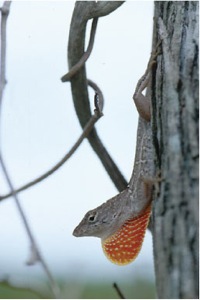
Methods
Data on the native distribution of Anolis sagrei was obtained from the Global Biodiversity Information Facility website (http://data.gbif.org/welcome.htm). Locality data was available for Cuba and the Bahamas. The geographic coordinates were entered into a spreadsheet and imported into Diva-GIS. The imported coordinates were then converted to a shapefile to be used for the analysis. Administrative boundary and inland water body data was obtained from the Diva-GIS website for the United States, Cuba, and the Bahamas. An equal area cylindrical projection with the WGS 84 datum was used for these maps. For this type of analysis it is important that the maps be in an equal area projection to ensure that the grid cells are of equivalent size. The native distribution of Anolis sagrei within Cuba and the Bahamas is shown in Figure 1.
After importing the relevant administrative, water body, and native distribution shapefiles into the Diva-GIS application, the BIOCLIM algorithm was run. Six output variable types are available and for this analysis the Domain output variable was chosen.
The output assigns colors ranging from dark green(very poor suitability) to red(very high suitability) for the areas analyzed. These colors are based on a Gower distance statistic. It is based on the absolute distance value between each of the input points (known native range points) and each grid cell divided by the range of the variable for all grid cells. This is calculated for each climate variable and the final value given for each grid cell is the mean for all of the climate distances for each grid cell. Areas with Gower Distances (GD) between 50-90 are indicated with dark green. Good climatic similarity is shown by Gower Distances above 95 which corresponds to light green coloration. The colors yellow(GD=96-97), orange (GD= 98-99), and red (GD=100) indicate increasing levels of suitability. (Hijmans et. al. 2005) The climatic suitability was then qualitatively compared to known invasive distributions.
